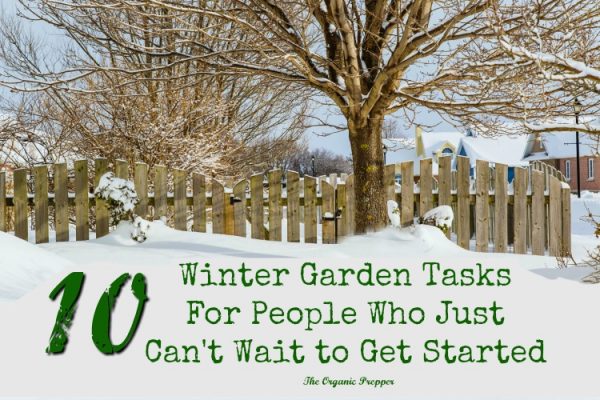If you’re itching for gardening season to start, you’re in luck. You can start now with the clean hands, no backache part. Whether or not you’ve grown a garden before, there are plenty of tasks you can do during the colder months to get ready for spring. Not using this more barren time means that your planting will be delayed and your harvests will not be as good as they would have if you had been ready to go.
Planning your garden is a crucial step in getting a decent bounty at harvest time, but there’s a lot more to it than just allocating space in your veggie plot. As I discussed last fall in this interview, you need to work on becoming more self-sufficient NOW, regardless of where you live. You don’t have to have 30 acres in the country to produce at least some of your own food.
Here are a few things you can do during the winter.
Some of these things require that the snow already be melted, while others can be done even if it’s up to your knees.
1) Pick up any downed branches
Chop them into the appropriate sizes and set them aside for firewood or kindling. They’ll need to dry out for a season or two, but it’s a good way to add to your wood stash for free.
Bundling sticks for a perfect fire
2) Rake the leaves.
If the snow has melted, rake your garden to get rid of smaller debris and leaves. (I like this rake because the head is expandable and can work for various nooks and crannies.) Either bag up the leaves so they turn into mulch or add them to the compost bin.
3) Kick the composting into high gear.
If you have a smaller space, rotating compost bins are ideal and make compost super fast. They are the perfect size for those who need small amounts of compost for container growing.
4) Dig up any perennial weeds that have survived the winter.
If the snow has melted and the ground isn’t still frozen rock hard, you can begin attacking those stubborn weeds before things get overgrown. Check every week for new arrivals poking through especially as we move toward warmer weather.
- If you have any kind of chronic pain or mobility issues, this nifty tool makes weed removal far easier.
- Remove winter weeds and sleeping snails before spring
5) Decide what you are going to grow.
Having a garden that can supply the maximum nutrients to you family will be of prime importance if the time comes when you can’t get to the store to stock up.
- The 14 Best Things You Can Grow in a Survival Garden
- Home Canning: How many tomato plants will you need?
- Growing a Garden: How much should you plant?
6) Order your seeds.
Be sure to buy heirloom seeds so you can save them year after year, something that will be critical after a long-term disaster. Get a wide a variety of seeds for long term storage. And come on, who doesn’t love curling up in front of the fire with a pile of seed catalogs?
- The best seed catalogs out there
- The 15 best seed catalogs for organic gardeners
- The top 12 garden seed catalogs
7) Check for restrictions in your neighborhood.
The laws and regulations targeting small growers could potentially make growing your own veggies illegal. Many HOAs make it difficult to be self-reliant. Check your local regulations – no one wants to deal with the “garden police.”
- You could actually go to jail for growing vegetables in your front yard in some places
- The EU is seeking to ban heirloom seeds
- In the UK you can only buy heirloom seeds if you are a member of a private garden club
- Gardening Like a Ninja: A guide to sneaking delicious edibles into your landscape
8) Get your greenhouse ready.
Greenhouses should be completely emptied. Remember that rodents love make a cozy home in greenhouses. If you have one of the plastic ones (like this), they should be cleaned top to bottom to ensure no mood, spores or moss that can affect your tender plants are present.
- Prepare your greenhouse for spring
- 5 things you need to do to prep your greenhouse for spring
- How to clean your greenhouse
9) Get your pots ready.
Do you save the little pots from the nursery to use year after year? Be sure to clean them properly to ensure they are free of anything that might contaminate your new plants. Check them for leaks or cracks before planting in them.
- 7 DIY seed pots from common household items
- Get your pots or containers ready for planting (video)
- How to wash and disinfect plant containers
- The dos and don’ts of reusing flower pots
10) Test your soil.
If your soil isn’t too hard to dig up a little, it’s a great idea to check the chemistry of your soil so that you can be sure your veggies will thrive. This will help you figure out what type of amendments you will need.
- This is a great kit to keep on hand for soil testing.
- Check for anything lurking under your soil that could affect your plants
by Daisy Luther





